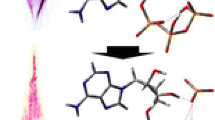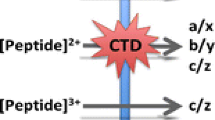Abstract
This study presents a detailed experimental investigation of charge isomers of protonated 4-quinolone antibiotics molecules formed during electrospray ionization (ESI) with proposed dissociation mechanisms after collisional activation. Piperazinyl quinolones have been previously shown to exhibit erratic behavior during tandem MS analyses of biological samples, which originated from varying ratios of two isomeric variants formed during ESI. Here, a combination of ESI-collision-induced dissociation (CID), differential ion mobility spectrometry (DMS), high resolution MS, and density functional theory (DFT) was used to investigate the underlying mechanisms of isomer formation and their individual dissociation behaviors. The study focused on ciprofloxacin; major findings were confirmed using structurally related 4-quinolones. DFT calculations showed a reversal of basicity for piperazinyl quinolones between liquid and gas phase. We provide an experimental comparison and theoretical treatment of factors influencing the formation ratio of the charge isomers during ESI, including solvent pH, protic/aprotic nature of solvent, and structural effects such as pK a and proton affinity. The actual dissociation mechanisms of the isomers of the protonated molecules were studied by separating the individual isomers via DMS-MS, which allowed type-specific CID spectra to be recorded. Both primary CID reactions of the two charge isomers originated from the same carboxyl group by charge-remote (CO2 loss) and charge-mediated (H2O loss) fragmentation of the piperazinyl quinolones, depending on whether the proton resides on the more basic keto or the piperazinyl group, followed by a number of secondary dissociation reactions. The proposed mechanisms were supported by calculated energies of precursors, transition states, and products for competing pathways.

ᅟ






Similar content being viewed by others
References
Andriole, V.T.: The Quinolones. Academic Press, London (1988)
Gootz, T.D., Brighty, K.E.: Fluoroquinolone antibacterials: SAR mechanism of action, resistance, and clinical aspects. Med. Res. Rev. 16, 433–486 (1996)
Neu, H.C.: The crisis in antibiotic resistance. Science 257, 1064–1073 (1992)
Lucchetti, D., Fabrizi, L., Guandalini, E., Podestà, E., Marvasi, L., Zaghini, A., Coni, E.: Long depletion time of enrofloxacin in rainbow trout (Oncorhynchus mykiss). Antimicrob. Agents Chemother. 48, 3912–3917 (2004)
Hernández-Arteseros, J.A., Barbosa, J., Compañó, R., Prat, M.D.: Analysis of quinolone residues in edible animal products. J. Chromatogr. A 945, 1–24 (2002)
Schneider, M.J.: Methods for the analysis of fluoroquinolones in biological fluids. Bioanalysis 1, 415–435 (2009)
Volmer, D.A., Mansoori, B.A., Locke, S.J.: Study of 4-quinolone antibiotics in biological samples by short-column liquid chromatography coupled with electrospray ionization tandem mass spectrometry. Anal. Chem. 69, 4143–4155 (1997)
D’Agostino, P.A., Hancock, J.R., Provost, L.R.: Electrospray mass spectrometric characterization of fluoroquinolone antibiotics: norfloxacin, enoxacin, ciprofloxacin, and ofloxacin. Rapid Commun. Mass Spectrom. 9, 1038–1043 (1995)
Raju, B., Ramesh, M., Borkar, R.M., Srinivas, R., Padiya, R., Banerjee, S.K.: In vivo metabolic investigation of moxifloxacin using liquid chromatography/electrospray ionization tandem mass spectrometry in combination with online hydrogen/deuterium exchange experiments. Rapid Commun. Mass Spectrom. 26, 1817–1831 (2012)
Gajda, A., Posyniak, A., Zmudzki, J., Gbylik, M., Bladek, T.: Determination of (fluoro)quinolones in eggs by liquid chromatography with fluorescence detection and confirmation by liquid chromatography-tandem mass spectrometry. Food Chem. 15, 430–439 (2012)
McMullen, S.E., Schenck, F.J., Vega, V.A.: Rapid method for the determination and confirmation of fluoroquinolone residues in catfish using liquid chromatography/fluorescence detection and liquid chromatography-tandem mass spectrometry. J. AOAC Int. 92, 12312–12340 (2009)
Toussaint, B., Chedin, M., Bordin, G., Rodriguez, A.R.: Determination of (fluoro)quinolone antibiotic residues in pig kidney using liquid chromatography-tandem mass spectrometry. I. Laboratory-validated method. J. Chromatogr. A 1088, 32–39 (2005)
Kaufmann, A., Butcher, P., Maden, K., Widmer, M., Giles, K., Uría, D.: Are liquid chromatography/electrospray tandem quadrupole fragmentation ratios unequivocal confirmation criteria? Rapid Commun. Mass Spectrom. 23, 985–998 (2009)
Wang, J., Aubry, A., Bolgar, M.S., Gu, H., Olah, T.V., Arnold, M., Jemal, M.: Effect of mobile phase pH, aqueous-organic ratio, and buffer concentration on electrospray ionization tandem mass spectrometric fragmentation patterns: implications in liquid chromatography/tandem mass spectrometric bioanalysis. Rapid Commun. Mass Spectrom. 24, 3221–3229 (2010)
Neta, P., Godugu, B., Liang, Y., Simón-Manso, Y., Yang, X., Stein, S.E.: Electrospray tandem quadrupole fragmentation of quinolone drugs and related ions. On the reversibility of water loss from protonated molecules. Rapid Commun. Mass Spectrom. 24, 3271–3278 (2010)
Colorado, A., Brodbelt, J.: Class-selective collisionally activated dissociation/ion-molecule reactions of 4-quinolone antibiotics. Anal. Chem. 66, 2330–2335 (1994)
Lapthorn, C., Dines, T.J., Chowdhry, B.Z., Perkins, G.L., Pullen, F.S.: Can ion mobility mass spectrometry and density functional theory help elucidate protonation sites in ‘small’ molecules? Rapid Commun. Mass Spectrom. 27, 2399–2410 (2013)
Tian, Z., Kass, S.R.: Gas-phase versus liquid-phase structures by electrospray ionization mass spectrometry. Angew. Chem. Int. Ed. Engl. 48, 1321–1323 (2009)
Schmidt, J., Meyer, M.M., Spector, I., Kass, S.R.: Infrared multiphoton dissociation spectroscopy study of protonated p-aminobenzoic acid: does electrospray ionization afford the amino- or carboxy-protonated ion? J. Phys. Chem. A 115, 7625–7632 (2011)
Tian, Z., Wang, X.B., Wang, L.S., Kass, S.R.: Are carboxyl groups the most acidic sites in amino acids? Gas-phase acidities, photoelectron spectra, and computations on tyrosine, p-hydroxybenzoic acid, and their conjugate bases. J. Am. Chem. Soc. 131, 1174–1181 (2009)
Tian, Z., Kass, S.R.: Does electrospray ionization produce gas-phase or liquid-phase structures? J. Am. Chem. Soc. 130, 10842–10843 (2008)
Caravatti, P., Allemann, M.: The ‘infinity cell’: a new trapped-ion cell with radiofrequency covered trapping electrodes for fourier transform ion cyclotron resonance mass spectrometry. Org. Mass Spectrom. 26, 514–518 (1991)
Qi, Y., O’Connor, P.B.: Data processing in Fourier transform ion cyclotron resonance mass spectrometry. Mass Spectrom. Rev. 33, 333–352 (2014)
Koch, W., Holthausen, M.C.: A chemist’s guide to density functional theory. Wiley-VCH, Weinheim (2000)
Frisch, M.J., Trucks, G.W., Schlegel, H.B., Scuseria, G.E., Robb, M.A., Cheeseman, J.R., Montgomery Jr., J.A., Vreven, T., Kudin, K.N., Burant, J.C., Millam, J.M., Iyengar, S.S., Tomasi, J., Barone, V., Mennucci, B., Cossi, M., Scalmani, G., Rega, N., Petersson, G.A., Nakatsuji, H., Hada, M., Ehara, M., Toyota, K., Fukuda, R., Hasegawa, J., Ishida, M., Nakajima, T., Honda, Y., Kitao, O., Nakai, H., Klene, M., Li, X., Knox, J.E., Hratchian, H.P., Cross, J.B., Bakken, V., Adamo, C., Jaramillo, J., Gomperts, R., Stratmann, R.E., Yazyev, O., Austin, A.J., Cammi, R., Pomelli, C., Ochterski, J.W., Ayala, P.Y., Morokuma, K., Voth, G.A., Salvador, P., Dannenberg, J.J., Zakrzewski, V.G., Dapprich, S., Daniels, A.D., Strain, M.C., Farkas, O., Malick, D.K., Rabuck, A.D., Raghavachari, K., Foresman, J.B., Ortiz, J.V., Cui, Q., Baboul, A.G., Clifford, S., Cioslowski, J., Stefanov, B.B., Liu, G., Liashenko, A., Piskorz, P., Komaromi, I., Martin, R.L., Fox, D.J., Keith, T., Al-Laham, M.A., Peng, C.Y., Nanayakkara, A., Challacombe, M., Gill, P.M.W., Johnson, B., Chen, W., Wong, M.W., Gonzalez, C., Pople, J.A.: Gaussian 03, Revision E.01. Gaussian, Inc, Wallingford (2004)
Boese, A.D., Martin, J.M.L.: Development of density functionals for thermochemical kinetics. J. Chem. Phys. 121, 3405–3416 (2004)
Babić, S., Horvat, A.J.M., Pavlović, D.M., Kaštelan-Macan, M.: Determination of pK a values of active pharmaceutical ingredients. Trends Anal. Chem. 26, 1043–1061 (2007)
Lin, C.E., Deng, Y., Liao, W.S., Sun, S.W., Lin, W.Y., Chen, C.C.: Electrophoretic behavior and pK a determination of quinolones with a piperazinyl substituent by capillary zone electrophoresis. J. Chromatogr. A 1051, 283–290 (2004)
Qiang, Z., Adams, C.: Potentiometric determination of acid dissociation constants (pK a) for human and veterinary antibiotics. Water Res. 38, 2874–2890 (2004)
Barbosa, J., Fonrodona, G., Marqués, I., Butí, S., Toro, I.: Factor analysis applied to the correlation between dissociation constants and solvatochromic parameters in water–acetonitrile mixtures. 1. Solvent effects on the dissociation of carboxylic acid groups in some diuretics, quinolones, buffers and peptides. Trends Anal. Chem. 16, 104–111 (1997)
Barrón, D., Irles, J., Barbosa, J.: Prediction of electrophoretic mobilities in non-aqueous capillary electrophoresis. Optimal separation of quinolones in acetonitrile–water media. J. Chromatogr. A 871, 367–380 (2000)
Maksic, Z.B., Kovačević, B.: Absolute proton affinity of some polyguanides. J. Org. Chem. 65, 3303–3309 (2000)
Maksic, Z.B., Kovačević, B.: Toward organic superbases: the electronic structure and the absolute proton affinity of quinodiimines and some related compounds. J. Phys. Chem. A 102, 7324–7328 (1998)
Kovačević, B., Maksic, Z.B.: Toward engineering of very strong organic bases: pronounced proton affinity of molecules possessing imino structural and electronic motif. Chem. Phys. Lett. 288, 289–292 (1998)
Hunter, E.P.L., Lias, S.G.: Evaluated gas phase basicities and proton affinities of molecules: an update. J. Phys. Chem. Ref. Data 27, 413–656 (1998)
Mansoori, B.A., Volmer, D.A., Boyd, R.K.: Wrong-way-round electrospray ionization of amino acids. Rapid Commun. Mass Spectrom. 11, 1120–1130 (1997)
Zhou, S., Cook, K.D.: Protonation in electrospray mass spectrometry: wrong-way-round or right-way-round? J. Am. Soc. Mass Spectrom. 11, 961–966 (2000)
Gatlin, C.L., Tureček, F.: Acidity determination in droplets formed by electrospraying methanol-water solutions. Anal. Chem. 66, 712–718 (1994)
Campbell, J.L., Le Blanc, J.C., Schneider, B.B.: Probing electrospray ionization dynamics using differential mobility spectrometry: the curious case of 4-aminobenzoic acid. Anal. Chem. 84, 7857–7864 (2012)
Bailac, S., Barrón, D., Sanz-Nebot, V., Barbosa, J.: Determination of fluoroquinolones in chicken tissues by LC-coupled electrospray ionization and atmospheric pressure chemical ionization. J. Sep. Sci. 29, 131–136 (2006)
Adams, J., Gross, M.L.: Energy requirement for remote charge site ion decompositions and structural information from collisional activation of alkali metal cationized fatty alcohols. J. Am. Chem. Soc. 108, 6915–6921 (1986)
Adams, J., Gross, M.L.: Charge-remote fragmentations of closed-shell ions. A thermolytic analogy. J. Am. Chem. Soc. 111, 435–440 (1989)
Sleno, L., Windust, A., Volmer, D.A.: Structural study of spirolide marine toxins by mass spectrometry. Part I. Fragmentation pathways of spirolide desmethyl-C by collision-induced dissociation and infrared multiphoton dissociation mass spectrometry. Anal. Bioanal. Chem. 378, 969–976 (2004)
Barbosa, J., Bergés, R., Sanz-Nebot, V.: Linear solvation energy relationships in reversed-phase liquid chromatography. Prediction of retention of several quinolones. J. Liquid Chromatogr. 18, 3445–3463 (1995)
Takács-Novák, K., Noszál, B., Hermecz, I., Keresztúri, G., Podányi, B., Szász, G.: Protonation equilibria of quinolone antibacterials. J. Pharm. Sci. 79, 1023–1028 (1990)
Takács-Novák, K., Józan, M., Hermecz, I., Szász, G.: Lipophilicity of antibacterial fluoroquinolones. Int. J. Pharm. 79, 89–98 (1992)
Acknowledgments
D.A.V. and B.K. acknowledge joint funding from a bilateral research program of the German Academic Exchange Service (DAAD) and the Croatian Ministry of Science, Education, and Sports (MZOŠ). B.K. thanks the Computing Center of the University of Zagreb (SRCE) for computational time on the ISABELLA cluster. D.A.V. acknowledges general research support by the Alfried Krupp von Bohlen und Halbach Stiftung.
Author information
Authors and Affiliations
Corresponding author
Electronic supplementary material
Below is the link to the electronic supplementary material.
ESM 1
(PDF 1379 kb)
Rights and permissions
About this article
Cite this article
Kovačević, B., Schorr, P., Qi, Y. et al. Decay Mechanisms of Protonated 4-Quinolone Antibiotics After Electrospray Ionization and Ion Activation. J. Am. Soc. Mass Spectrom. 25, 1974–1986 (2014). https://doi.org/10.1007/s13361-014-0972-2
Received:
Revised:
Accepted:
Published:
Issue Date:
DOI: https://doi.org/10.1007/s13361-014-0972-2




